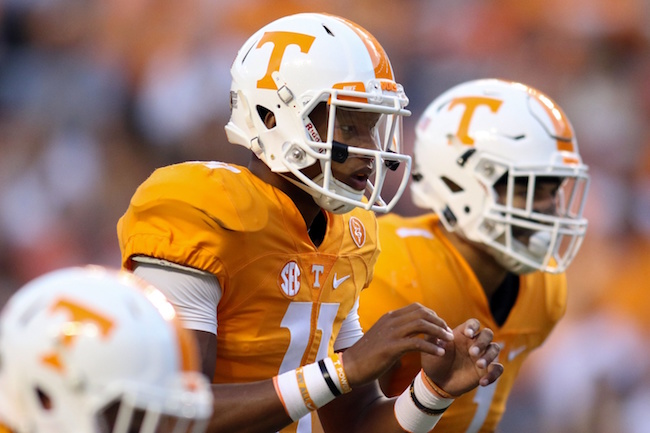
Joshua Dobbs hasn't evolved into true dual-threat QB
This was supposed to be a big year for Tennessee QB Joshua Dobbs.
He led the Volunteers to a 4-1 finish last season, capped off by a 45-28 win over Iowa in the TaxSlayer Bowl. The spark provided by Dobbs and the change in UT’s offense gave Team 119 a high ceiling, including a potential dark horse Heisman Trophy candidacy for the junior quarterback if he could lead the squad to Atlanta and beyond.
But expectations have deflated after a 2-2 September. Losses to Oklahoma and Florida have demonstrated that the mobile, hard-running Dobbs has not evolved into a true dual-threat quarterback, and Tennessee’s passing game is virtually non-existent.
The lack of a passing attack is hard to stomach for a team that likes to call itself Wide Receiver U. It seems doubtful that the current problem is with the pass catchers. The Volunteers’ roster includes six wide receivers with Rivals recruiting ratings of four stars or higher. Position coach Zach Azzanni is in his third season on head coach Butch Jones’ staff. That combination of talent and continuity should make for a potent passing attack with the right quarterback.
The leading UT receiver in the Florida game, however, was Dobbs, solely for his 58-yard touchdown reception. Trick plays like WR Jauan Jennings’ pass to Dobbs can be great for a quick score or a much-needed first down, but Tennessee’s primary passing game obviously needs to come from the quarterback position.
Whether it’s due to Dobbs’ decision-making, protection issues or offensive coordinator Mike DeBord’s play calls, or some combination of all three, passing numbers are surprisingly low for the Volunteers this season. Through Week 4, Dobbs has only logged 91 passing attempts for 557 yards. Only two current first-string quarterbacks with multiple starts have fewer attempts: Georgia’s Greyson Lambert (68 in four games) and LSU’s Brandon Harris (47 in three games).
As broken down in an excellent video by WBIR’s Patrick Murray, Dobbs demonstrated last season that he can lead a passing offense. He was very effective on short passes and rollout plays. Those types of pass plays along with designed runs helped Tennessee’s offense increase from 4.4 yards per play to 5.5 yards per play when Dobbs took over as the starting quarterback.
The deep pass was missing with Dobbs last year, and unfortunately, nearly a year later it still hasn’t been established. Without a deep passing game, teams like Oklahoma and Florida are demonstrating there’s little risk to repeatedly pressuring Tennessee and taking chances on pass coverage.
DeBord’s background is in a pro-style offense, but UT’s talent at wide receiver is being wasted if Dobbs is uncomfortable with the current passing calls and choosing to run. A one-dimensional offense of carries for RB Jalen Hurd and rushes for Dobbs might beat a few SEC teams – it almost worked against Florida – but Tennessee won’t take the next step until Dobbs evolves into a true dual-threat quarterback and forces opposing defense’s to respect the passing game and the pass catchers.
